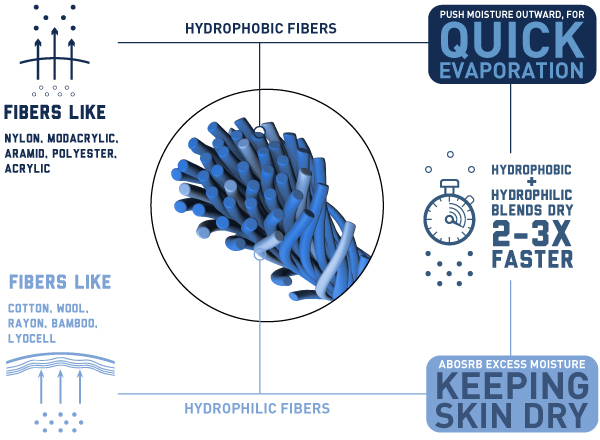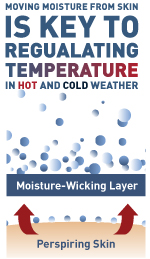Moisture Management for Cold Weather: Stay Dry, Warm, and Protected this Season
When your work requires you to be outside for long periods of time, being prepared for changes in the weather is not only about maintaining comfort, but it can also be crucial for protecting your health and safety on the job. As the autumn season transitions to cooler temperatures, it's time to rethink your approach to dressing, and factor in the changing environmental conditions. In this blog, we'll explore cold stress, and the important role staying dry plays in helping you maintain your comfort and productivity this fall and winter.
Cold Stress
Cold stress not only negatively impacts your health, but it can also have a real impact on your ability to work safely and effectively. Any extreme temperature, either hot or cold, causes the body to divert its energy to maintaining its core body temperature. This leaves little energy for productivity or cognitive functioning which can negatively impact your ability to perform the physical and mental tasks needed to do your job effectively. (W. Jon Williams, 2021).
According to the CDC, cold stress is the environmental condition in which the body starts to lose heat faster than it can produce it. Prolonged exposure to a cold stress environment can lead to Hypothermia. Most people think of hypothermia occurring in very cold temperatures; however, most cases occur in the spring and fall, and hypothermia can occur in temperatures above 40°F if a person is wet (including from sweat) (Centers for Disease Control and Prevention, 2019). The main environmental factors that contribute to cold stress are temperature, wind chill, dampness, and cold water (Princeton University, 2023).
Temperature Regulation
Sweating is a key part of our bodies’ natural temperature regulation process. As sweat evaporates from our skin it creates a natural cooling effect, helping us to maintain our ideal body temperature (Medical News Today, 2021). Staying dry is key for regulating your temperature in the cold as well, since dampness (even from sweat) can accelerate the rate of heat loss from the body. One of the primary risk factors that contributes to cold stress is moisture, which is why OSHA recommends a moisture wicking layer against the skin as part of their cold stress (Occupational Safety and Health Administration, 2023). In addition to sweating, blood circulation also plays an important role in maintaining your temperature (Medical News Today, 2021).
OSHA recommends dressing in light, loose layers to allow proper
circulation and heat to radiate from your skin. Lightweight layers allow you to adjust your level of thermal protection throughout the day as conditions change so you can maintain warmth without overheating. The air gaps between layers play an active role in providing insulation while keeping protection light, which can also help in maintaining mobility (Occupational Safety and Health Administration, 2023).
Moisture Management
The dampness of clothes can not only make you feel colder and uncomfortable but increases the risk of cold-related issues like hypothermia and frostbite. Keeping skin and clothes dry is key to staying warm and comfortable in the cold. This is where moisture management comes into play. Moisture Management is the process of moving perspiration (moisture) from the skin through fabric and then into the atmosphere to be evaporated. This is done most effectively when a fabric utilizes a combination of both Hydrophilic and Hydrophobic fibers (Motlogelwa, 2018).

Hydrophilic fibers like cotton naturally absorb moisture. Cotton-rich fabrics are not recommended for cold weather layering because cotton is 100% hydrophilic and retains moisture. This decreases its insulation value and leaves you feeling cold and clammy (Princeton University, 2023). Hydrophobic fibers like modacrylic naturally repel or do not absorb moisture easily. When combined, Hydrophilic and Hydrophobic fibers work together to quickly absorb or wick perspiration from the skin and push it out to the surface of the fabric so it can quickly evaporate (M. Basuk, 2018). When the right ratios are used, it can result in fabrics that dry 2-3 times faster than 100% cotton, keeping skin and clothing dry and comfortable.
Conclusion
There are many other actions you can take to combat the cold while working outside. Clothing selection is just one part of a cold stress mitigation plan. To learn about cold stress prevention and safety check out OSHA’s Cold Stress Guide and the CDC’s page on Preventing Hypothermia & Frostbite.
Embrace the power of body’s natural temperature regulation with clothing that works for you not against you. Layering and moisture management are critical aspects of dressing for cold weather. Don't let cold weather slow you down – stay dry, stay warm, and own every mission.
Looking for a moisture wicking base layer? Explore our range of cold weather workwear and discover the perfect base layer to keep you comfortable and protected by visiting our Cold Weather Landing Page: https://www.thinknsa.com/cold-weather-protection
We have plenty of stock styles ready to ship! Contact Customer Service to place your order today. customerservice@thinknsa.com.
References
Centers for Disease Control and Prevention. (2019, February 8). Prevent Hypothermia & Frostbite. Retrieved from Centers for Disease Control and Prevention: https://www.cdc.gov/disasters/winter/staysafe/hypothermia.html
Basuk, M. C. (2018). Moisture Management Properties of Textiles. Curr Trends in Fashion Technology and Textile Engineering.
Medical News Today. (2021, October 8). What is thermoregulation, and how does it work? Retrieved from Medical News Today: https://www.medicalnewstoday.com/articles/thermoregulation#summary
Motlogelwa, S. (2018). Comfort and durability in high-performance clothing. In J. M. Sabir, High-Performance Apparel (pp. 209-219). Woodhead Publishing.
Occupational Safety and Health Administration. (2023, November). Cold Stress Guide. Retrieved from OSHA: https://www.osha.gov/emergency-preparedness/guides/cold-stress
Occupational Safety and Health Administration. (2023, February 17). Winter Weather. Retrieved from OSHA: https://www.osha.gov/winter-weather/cold-stress
Princeton University. (2023, November). Cold Stress Facts. Retrieved from Princeton University Environmental Health and Safety: https://ehs.princeton.edu/workplace-construction/occupational-health/heat-cold-stress/cold-stress-facts
Jon Williams, P. a. (2021, February 24). The Physiological Response of Working in Cold Environments and how your PPE can Help. Retrieved from Centers for Disease Control and Prevention: https://blogs.cdc.gov/niosh-science-blog/2021/02/24/cold_ppe/

Stay in the loop.
Sign up for our emails to be the first to know about exclusive product offerings
and all things DRIFIRE.











